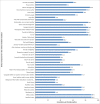Poor consistency in evaluating South African adults with neurogenic dysphagia
- PMID: 28155280
- PMCID: PMC5842977
- DOI: 10.4102/sajcd.v64i1.158
Poor consistency in evaluating South African adults with neurogenic dysphagia
Abstract
Background: Speech-language therapists are specifically trained in clinically evaluating swallowing in adults with acute stroke. Incidence of dysphagia following acute stroke is high in South Africa, and health implications can be fatal, making optimal management of this patient population crucial. However, despite training and guidelines for best practice in clinically evaluating swallowing in adults with acute stroke, there are low levels of consistency in these practice patterns.
Objective: The aim was to explore the clinical practice activities of speech-language therapists in the clinical evaluation of swallowing in adults with acute stroke. Practice activities reviewed included the use and consistency of clinical components and resources utilised. Clinical components were the individual elements evaluated in the clinical evaluation of swallowing (e.g. lip seal, vocal quality, etc.)Methods: The questionnaire used in the study was replicated and adapted from a study increasing content- and criterion-related validity. A narrative literature review determined what practice patterns existed in the clinical evaluation of swallowing in adults. A pilot study was conducted to increase validity and reliability. Purposive sampling was used by sending a self-administered, electronic questionnaire to members of the South African Speech-Language-Hearing Association. Thirty-eight participants took part in the study. Descriptive statistics were used to analyse the data and the small qualitative component was subjected to textual analysis.
Results: There was high frequency of use of 41% of the clinical components in more than 90% of participants (n = 38). Less than 50% of participants frequently assessed sensory function and gag reflex and used pulse oximetry, cervical auscultation and indirect laryngoscopy. Approximately a third of participants showed high (30.8%), moderate (35.9%) and poor (33.3%) consistency of practice each. Nurses, food and liquids and medical consumables were used usually and always by more than 90% of participants.
Conclusion: Infrequent use of clinical components and high variability in clinical practice among speech-language therapists calls for uniform curricula in the clinical evaluation of swallowing at South African universities and for continued professional development post-graduation. Different contexts and patient symptoms contribute towards varied practice; however, there is still a need to improve consistency of practice for quality health care delivery. A research-based policy for the clinical swallowing evaluation for a resource-limited context is also needed.
Conflict of interest statement
The authors declare that they have no financial or personal relationships which may have inappropriately influenced them in writing this article.
Figures



Similar articles
-
Comparative Validity of the American Speech-Language-Hearing Association's National Outcomes Measurement System, Functional Oral Intake Scale, and G-Codes to Mann Assessment of Swallowing Ability Scores for Dysphagia.Am J Speech Lang Pathol. 2019 May 27;28(2):424-429. doi: 10.1044/2018_AJSLP-18-0072. Epub 2019 Feb 7. Am J Speech Lang Pathol. 2019. PMID: 31136231
-
Telehealth Stroke Dysphagia Evaluation Is Safe and Effective.Cerebrovasc Dis. 2017;44(3-4):225-231. doi: 10.1159/000478107. Epub 2017 Aug 19. Cerebrovasc Dis. 2017. PMID: 28848110 Clinical Trial.
-
Translation and Validation of the TOR-BSST Into Turkish for Stroke Patients.Int J Lang Commun Disord. 2025 May-Jun;60(3):e70042. doi: 10.1111/1460-6984.70042. Int J Lang Commun Disord. 2025. PMID: 40257040
-
Consensus-building on developing dysphagia competence: a North West of England perspective.Int J Lang Commun Disord. 2017 Nov;52(6):854-869. doi: 10.1111/1460-6984.12321. Epub 2017 Jun 19. Int J Lang Commun Disord. 2017. PMID: 28627039 Review.
-
The role of laryngeal hypersensitivity in dysphagia: A scoping review with embedded stakeholder involvement.Int J Lang Commun Disord. 2024 Nov-Dec;59(6):2333-2351. doi: 10.1111/1460-6984.13085. Epub 2024 Jul 1. Int J Lang Commun Disord. 2024. PMID: 38946667
Cited by
-
South African speech-language therapists' practices regarding feeding tube placement in people with advanced dementia.S Afr J Commun Disord. 2022 Dec 9;69(1):e1-e10. doi: 10.4102/sajcd.v69i1.927. S Afr J Commun Disord. 2022. PMID: 36546518 Free PMC article.
-
Decision making and the bedside assessment: The Speech Language Therapists' thinking when making a diagnosis at the bed.S Afr J Commun Disord. 2021 Jun 30;68(1):e1-e8. doi: 10.4102/sajcd.v68i1.790. S Afr J Commun Disord. 2021. PMID: 34212747 Free PMC article.
-
Dysphagia services in the era of COVID-19: Are speech-language therapists essential?S Afr J Commun Disord. 2020 Jul 29;67(1):e1-e6. doi: 10.4102/sajcd.v67i1.709. S Afr J Commun Disord. 2020. PMID: 32787417 Free PMC article.
-
Triage and dysphagia: Are hospitals in the South African public health sector ready?S Afr J Commun Disord. 2022 Jun 30;69(1):e1-e4. doi: 10.4102/sajcd.v69i1.852. S Afr J Commun Disord. 2022. PMID: 35792572 Free PMC article.
-
Upper Airway Sensory Testing in Dysphagia - Implications for Clinical Practice and Future Research Directions.Dysphagia. 2025 Aug;40(4):920-930. doi: 10.1007/s00455-024-10789-w. Epub 2024 Dec 3. Dysphagia. 2025. PMID: 39625497 Free PMC article.
References
-
- Albini R.M.N., Soares V.M.N., Wolf A.E., & Goncalves C.G.D.O (2013). Knowledge of nursing professionals about the care to dysphagic patients in intensive care units. Revista CEFAC, 15(6), 1512–1524. http://dx.doi.org/10.1590/S1516-18462013005000047 - DOI
-
- American Speech-Language-Hearing Association (2004). Preferred practice patterns for the profession of speech-language pathology. [Preferred practice patterns]. Retrieved June 29, 2014, from http://www.asha.org/policya - PubMed
-
- American Speech-Language-Hearing Association (2005). Evidence-based practice in communication disorders. [Position statement]. Retrieved from http://www.asha.org/policy/PS2005-00221.htm
-
- Babbie E., & Mouton J (2001). The practice of social research: South African edition. Cape Town, South Africa: Oxford University Press.
-
- Balzer K.M. (2000). Drug-induced dysphagia. International Journal of MS Care, 2(1), 6–7. http://dx.doi.org/10.7224/1537-2073-2.1.40 - DOI
Publication types
MeSH terms
LinkOut - more resources
Full Text Sources
Other Literature Sources
Medical
